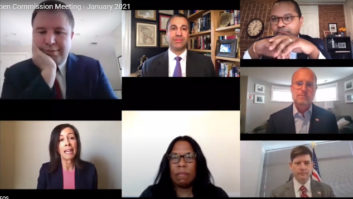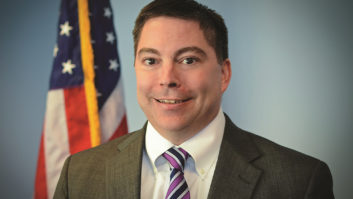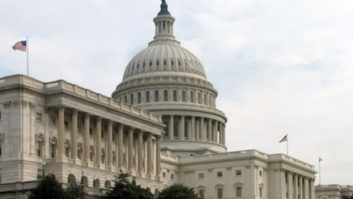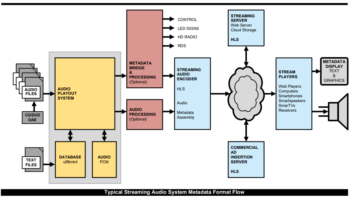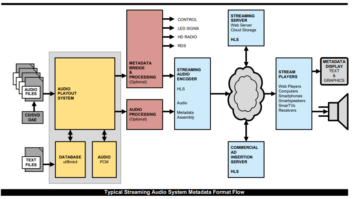FCC Chairman Ajit Pai made his inaugural trip to Capitol Hill on Wednesday to speak with the Senate Commerce, Science and Transportation Committee. Here are his prepared remarks.
Chairman Thune, Ranking Member Nelson, and Members of the Committee, thank you for giving me the opportunity to testify today. For almost five years, it has been an honor to work with many of you on a wide variety of issues. Now, in my new role as Chairman of the Federal Communications Commission, I look forward to continued collaboration as we try to bring digital opportunity to all Americans.
I would like to discuss four areas I will be emphasizing so long as I am privileged to serve as chairman: closing the digital divide; promoting innovation; protecting consumers and public safety; and reforming the FCC’s processes.
1. Closing the Digital Divide. — High-speed internet access, or broadband, is critical to economic opportunity. But there are still too many parts of this country where broadband is unavailable or unaffordable. There is a real and growing digital divide in America. In wealthier, metropolitan areas, 4G LTE is ubiquitous, and gigabit fixed service is expanding. But many rural areas are being left behind.
I’ve seen this firsthand in my travels across the country. In West Virginia, for example, Sen. Capito and I met with small business owners who were frustrated by their lack of high-quality broadband access — and we heard how fixing the problem could revitalize their economy. I’ve been to the far reaches of Alaska and heard from Alaska Natives that a lack of middle-mile connectivity has made it harder to connect their communities. And I have listened to people in Kansas and South Dakota and Nevada and Mississippi and elsewhere who worry that without broadband, they and their children won’t have the ability to compete and prosper in the 21st century.
The FCC has tools that it can use to help close this digital divide. First, we can more wisely apply federal funds under the Universal Service Fund programs that we administer. Second, we can revise regulations that deter the private sector from investing in next-generation networks. Finally, we can aid state and local governments, as well as the private sector, by creating deployment-friendly best practices. With these tools, we could bring down the cost of deploying broadband and create incentives for providers to connect consumers in hard-to-serve areas.
We are already using these tools and turning the aspiration of ubiquitous Internet access into reality.
First, with respect to subsidies: On Feb. 23, the FCC adopted two separate orders to spur the buildout of mobile and fixed broadband networks in rural America, and with that took two major steps toward connecting rural America.
One order involves what is known as Mobility Fund Phase II. The goal of the Mobility Fund is to ensure that all Americans have access to advanced wireless services. But not all do. I myself was struck, during a recent drive from Wichita, Kan.. to Des Moines, Iowa, how often the signal on my mobile phone was either weak or nonexistent. And that was even on relatively major roads such as Interstate 35.
In order to solve this problem, the FCC adopted, on a bipartisan basis, a plan to bring 4G LTE service to millions of rural Americans who don’t have it today. Over 10 years, we will spend over $4.5 billion to bring mobile broadband to unserved areas. And by distributing this money through a reverse auction, we will ensure that we do so in a fiscally responsible way.
I appreciate the bipartisan support this initiative has received in Congress (including on this committee) and at the commission. And I look forward to working with my colleagues and all of you as we start implementing our plan.
Turning to the second order, the FCC also voted on Feb. 23 to finalize the rules for allocating nearly $2 billion from the Connect America Fund, which aims to advance fixed broadband service across the country. Here again, we will direct financial support to deploy fixed broadband in unserved rural areas using a competitive reverse auction. My aim is to get the best deal for the American people with the limited funds we have available. And I am pleased that we were able to adopt this order on a bipartisan basis.
And in the FCC’s very first vote under my leadership, we approved — yet again on a bipartisan basis, and this time with bipartisan cooperation from Congress—a partnership with New York State to combine up to $170 million in federal universal service funds with state funds to deploy broadband in unserved areas in Upstate New York. This means that for the first time, thousands of people in the Empire State will finally have high-speed internet access.
In addition to providing targeted funding to expand broadband deployment in rural America, the FCC also can lower the cost of deployment through regulatory reform. We need to reduce the red tape and make it easier for broadband providers to build or expand next-generation networks. That’s why, on January 31, I announced the creation of the Broadband Deployment Advisory Committee, or BDAC. This advisory committee will focus on the best ways to promote broadband deployment. One of the BDAC’s key tasks will be to draft a deployment-friendly model code that any city or town could use as a template. And the BDAC will also look at reforms the FCC can adopt to lower the cost and expedite the process of broadband deployment. The response to the announcement of the BDAC’s formation has been tremendous. Over 380 individuals applied, and we are currently in the process of selecting the members and setting up the committee.
We also have already taken some important steps to clear regulatory burdens which inhibit broadband deployment. In February, for example, we ended the requirement that price cap carriers maintain a separate set of accounting books merely for regulatory purposes. Carriers were spending millions each year to maintain these accounts, even though career staff told us that in the last few years the FCC has never needed to rely on data they generated. By clearing away this regulation, carriers will be able to use those resources to invest in new networks rather than unnecessary paperwork. Later this month, we will also vote on reforming our cellular license rules. This will allow carriers to have greater flexibility in using their cellular licenses so they can more easily deploy 4G and 5G mobile services. These types of common-sense regulatory reforms aren’t particularly flashy, but they are vital to promoting aggressive build-out throughout our nation.
2. Promoting Innovation. — Another key priority for the FCC is to create a regulatory environment in which innovation can thrive. Entrepreneurs are constantly coming up with new technologies and services. But consumers aren’t well-served when outdated rules and bureaucratic inertia stand in the way of bringing them to the market.
Under my leadership, I want the FCC to facilitate, not frustrate, innovation. That’s why last month, for example, we started a proceeding aimed at allowing television broadcasters to innovate and fully enter the digital era. Engineers in the broadcast industry have been hard at work developing a new transmission standard that would let broadcasters merge the capabilities of over-the-air broadcasting with broadband connectivity. This Next Gen TV standard, also known as ATSC 3.0, is the first one to leverage the power of the Internet, and it promises to dramatically transform broadcasting.
With Next Gen TV, broadcasters could offer innovative technologies and services to consumers, including ultra-HD picture and immersive audio, improved over-the-air reception, and more localized content. This new standard would also enable better accessibility options for those with disabilities. It could enable advanced emergency alerting with alerts tailored to particular communities and wake up sleeping devices to warn consumers of imminent emergencies. And it could give consumers the ability to watch over-the-air programming from their mobile devices. But this new standard can’t be deployed without the approval of the FCC.
Fortunately, last month, the commission unanimously proposed to allow broadcasters to deploy Next Gen TV on a voluntary, market-driven basis. I hope that we will be able to give final approval for the standard by the end of the year.
But our work to promote innovation doesn’t stop there. Last month, the FCC authorized the first-ever LTE-U (LTE for unlicensed) devices in the 5 GHz band — a significant advance in wireless innovation and spectrum sharing. This means wireless consumers will get to enjoy the best of both worlds: a more robust, seamless experience when their devices are using cellular networks and the continued enjoyment of Wi-Fi, one of the most creative uses of spectrum in history.
The commission has also ended its investigation into the free-data offerings of wireless carriers. Innovative offerings like T-Mobile’s Binge On have been popular with consumers, particularly low-income Americans, and have enhanced competition in the marketplace. I firmly believe the commission should favor permissionless innovation in this fiercely competitive market — and rely on consumer choice to sort out what innovations best serve the public interest.
3. Protecting Consumers and Public Safety. — The FCC’s core mission has always been to serve the broader public interest, and that means protecting consumers and keeping the public safe. We have made progress on each front in just a month and a half.
That’s why I have teed up an aggressive agenda to target and eliminate unlawful robocalls. As a first step, the commission will vote this month on my proposal to let carriers block spoofed robocalls, that is, calls in which a scammer conceals his identity on Caller ID by using a fake number, such as a number associated with the IRS. The proposed rules would allow carriers to block spoofed calls where the owner of the number being spoofed requests it as well as calls that purport to come from unassigned or invalid phone numbers (there’s a database that keeps track of all phone numbers, and many of them aren’t assigned to a voice service provider or aren’t otherwise in use). There is no reason why any legitimate caller should be spoofing numbers in this way — it’s just a way for scammers to evade the law.
Another consumer protection is improving communications services for Americans who are deaf and hard of hearing. For 15 years, video relay service (VRS) has enabled deaf and hard-of-hearing individuals to call friends, family members, and others using American Sign Language (ASL) and a videophone, and to have their calls interpreted from signs to voice and vice versa. And for four years, I have been pushing to improve the quality of these services and make them more functionally equivalent to the voice services available to hearing individuals. Later this month, the commission will vote on concrete steps to do just that — steps such as a skills-based routing trial, standardized quality-of-service metrics, and letting VRS users call directly family members and friends who know ASL.
Another area in which we are working to help the American people is preventing the use of contraband cellphones in correctional facilities. I have visited several of these facilities, from a maximum security prison in Georgia to a minimum security unit in Massachusetts. And I’ve consistently heard stories of how contraband cellphones are used to run drug operations, to conduct phone scams, and to facilitate violent acts, including murders. The FCC proposed certain reforms four years ago to address this problem. This month, we will finally vote on some of them, such as enabling the use of radio-based technologies to detect and block the use of contraband phones in prisons and jails. I’ve also asked my colleagues to agree to solicit public input on other solutions for addressing this pressing problem, including disabling illicit devices and geo-fencing.
Furthermore, recent events have made clear that the FCC’s public safety role includes urgent short-term action, not just longer-term rulemaking. Last Wednesday, the agency received requests to grant a waiver to Jewish Community Centers and telecommunications carriers to allow them to identify the perpetrator(s) of violent threats to those centers in dozens of locations. I quickly reviewed the requests and directed the FCC staff to act with dispatch. They did. This past Friday, our Consumer and Governmental Affairs Bureau granted the emergency waiver (with commissioners’ assent, for which I am grateful). I hope this measure helps law enforcement apprehend and bring to justice any person who has made such threats.
4. Reforming the FCC’s Processes. — For many years, those inside and outside the agency have called for process reforms to make the work of the FCC more transparent. As a minority commissioner at the agency, I was not shy about pressing for changes that would give all commissioners greater say in the agency’s operations. And as a chairman, I have made it a priority to implement those reforms. I have taken meaningful steps to devolve power from the chairman’s office and return it to my colleagues and the agency as a whole. I want to highlight just a couple of those reforms today.
First, I always found it strange that the public was not allowed to see what the FCC was voting on until after the FCC voted. Of course, well-connected lobbyists could generally find out much of what was in the commission’s draft proposals and orders. But hundreds of millions of Americans were left in the dark.
As a commissioner, I was told that it simply was not practical to release the text of the documents prior to commission meetings. As chairman, I worked as quickly as possible to put that proposition to the test. On Feb. 2, three weeks before our February meeting, I started a pilot program and made public the full text of two draft items on the meeting’s agenda. Things went so well that last week, I made public the draft text of all six items for our March meeting, as well as one-page fact sheets and a public blog post describing them. Allowing anyone, anywhere to see these documents publicly is another step towards shedding more sunlight on the FCC’s operations.
I would like to thank Commissioner O’Rielly for his strong leadership on the issue of process reform. And I would like to commend Commissioner Clyburn for her suggestion that fact sheets accompany the release of draft meeting items. I’m optimistic that after this month’s meeting, we will be able to end the pilot program and establish permanent procedures for releasing items to the public three weeks in advance of our meetings. This is just one example of how I intend to make the FCC more open and accountable to the American people. I look forward to working with my colleagues to implement more process reforms in the weeks to come.
* * *
In the first six weeks of my chairmanship, we have hit the ground running. And let me emphasize the “we.” What we have accomplished so far is a tremendous credit to the nonpartisan, federal employees of the agency — our hard-working professional staff, who are the agency’s strongest assets. It is a credit to my colleagues Commissioner Clyburn and Commissioner O’Rielly, who have been integral in moving the agenda forward and doing so time after time on a bipartisan basis. And it is a credit to you, our congressional overseers, as well as other elected officials like Sen. Schumer, who have highlighted the many issues the FCC must tackle in a bipartisan manner. These past six weeks have only reaffirmed my view that no FCC office or floor holds a monopoly on wisdom.
And as we move forward, I hope we can continue to work together on a bipartisan basis to close the digital divide, promote innovation, protect consumers and public safety, and improve the FCC’s processes and procedures.
For more coverage see Broadcasting & Cable’s coverage here, here and here. And don’t forget to check its Washington News page as well for the latest.





